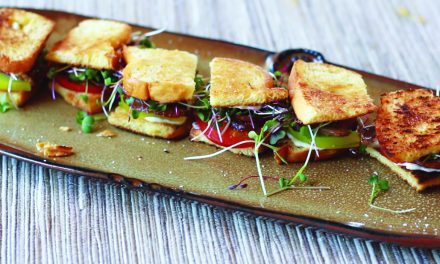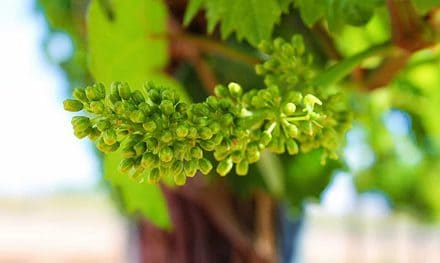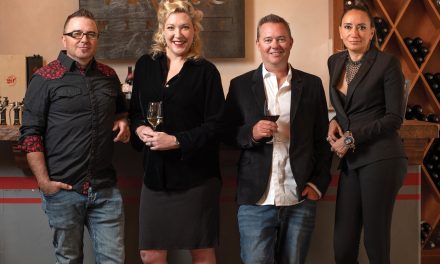
To Be Perfectly Franc
Old World Wines Win in New Mexico Soil by Michele Ostrove
Thirty-three years ago, the unthinkable happened in the wine world—a California Chardonnay and Cabernet Sauvignon beat their French counterparts in a formal blind wine tasting in Paris. The distinguished panel of French judges swirled, sniffed, sipped and spat, certain—until the results were revealed—that no American wine could possibly rival their venerable Bordeaux. “Ah, back to France!” sighed one after sipping a 1972 Napa Valley Chardonnay. “That is definitely California. It has no nose,” another judge declared after trying a 1973 Batard Montrachet.
Now, after the 2009 San Francisco Chronicle Wine Competition, it is New Mexico’s turn to be smug. A Cabernet Franc produced in southwestern New Mexico’s Mimbres Valley, the 2007 D.H. Lescombes made by Southwest Wines, won the competition’s prestigious Sweepstakes Award, sharing the “Best of Class” and “Best Red” honors (out of a field of 4,675 wines) with a California Syrah from Paso Robles. As with the “Judgment of Paris” in 1976, the judges were caught completely off-guard. Who knew New Mexico could be a wine force to be reckoned with?
“That not only a New Mexico wine but a Cabernet Franc could take a top honor is both improbable and very heartening,” said Jon Bonne, wine editor for the San Francisco Chronicle. “Cab Franc consistently gets zero respect, even from many winemakers, in part because the current industry has such a fear of herbaceous flavors in red wine. I hadn’t chosen the D.H. Lescombes as my top red wine in the sweepstakes judging, but it was in my top three or four and an excellent example of Cabernet Franc.”
The man behind the winning label, Southwest Wines’ President Hervè Lescombes, isn’t a native New Mexican – in fact, he was on French soil when the Judgment of Paris was rendered. Lescombes is a fifth-generation French
winemaker whose great-great-grandparents produced wine in Algeria to sell to France. (Under colonial French rule, North Africa was one of the most important winemaking regions in the world; in fact, Algeria’s dark reds were
often blended with lesser-quality Burgundy grapes in France to produce better wines.) When war broke out in Algeria in the early 1960s, the Lescombes fled to France and started the Domaine des Perignon vineyard in Burgundy, near Chablis. There, he met his wife Danielle (for whom the D in D.H. Lescombes is named) and had two sons and a daughter.
Four years before the Paris competition confirmed the burgeoning taste for fruitier, California-style wines, Lescombes had begun crafting them, prompted by requests from his Belgian and German customers. “The French technique at that time was to pick the grapes, crush them and place them in barrels for years,” he explained. “The tannins would drop, the wine would mellow, and the color would lighten. The wines would completely lose their fruity taste and were not pleasant to drink.”
Bringing the Best West
By the early 1980s, Lescombes decided it was time for a change. He sold his winery and headed to America. “I did not want to go to an established region like Napa because I did not have the money and wanted to do something on my own,” he said. Landing in New Mexico on a swing through the West, he observed that the climate was similar to where he had lived much of his life. Central New Mexico lacked the water needed for proper irrigation, so he settled his family in Las Cruces and planted his first wines in Lordsburg. The southern part of the state
had ideal elevation—just over 4,500 feet—and sandy, nutrient-rich soil that offered excellent drainage. Southern New Mexico’s hot, sunny days were punctuated by cool evenings, allowing the fruit to mature, build natural sugars and retain the acids necessary for premium winemaking. The result: intensity of flavor and heavy structure in the reds.
When Lescombes began planting his 180-acre vineyard in 1981, he found he was able to use many of the techniques he used in Algeria, both in the vineyard and the winemaking process. He installed an underground irrigation system to control the water supply and a state-of-the-art winery, but adhered to many Old World techniques, like aging in French oak barrels and hand-harvesting the grapes in the middle of the night.
Lescombes eventually found he could grow some 30 red and white varietals, ranging from the robust reds—Cabernet Franc, Cabernet Sauvignon, Syrah, Zinfandel, Petit Verdot and Mourvèdre—to dry Riesling and Gewurztraminer to the sparkling Bellissimo. Today, Southwest Wines produces more than 60 wines under eight different brands, targeted to a variety of tastes and price points. They include Blue Teal Vineyards, St. Clair Winery, PlumLoco, Summer Peach, Wine A-Rita and Chocolate d’Vine, available at grocery stores throughout the New Mexico, Colorado, Texas and Arizona; and the premium D.H. Lescombes, distributed at fine wine outlets.
Although Southwest Wines’ labels have been winning awards for years, the San Francisco Chronicle Wine Competition represented a culmination of their efforts, yielding 17 medals for 18 wines entered. Besides the
Sweepstakes Award, they captured Gold Medals for the Limited Release 2007 D.H. Lescombes Mourvèdre and the St. Clair Winery Port.
In keeping with the Lescombes tradition, Southwest Wines is a family operation—son Florent is vice president and chief winemaker (assisted by winemaker Philippe Littot, a Tunisian native who used to own the New Mexico winery Sandia Shadows); son Emmanuel works with his father in the vineyard. Over the past four years, the Lescombes have
opened full-service restaurants in Albuquerque and Las Cruces to augment their tasting room in Deming. The St. Clair Winery & Bistro offers reasonably priced country-style cuisine paired with a variety of their own varietals. “We wanted to transform consumers’ thoughts on New Mexico wines,” says Pacheco. Open for lunch and dinner, the bistros feature outdoor patios and live jazz Thursday through Sunday nights.
If you want to taste the Sweepstakes winner, better hurry—only 200 cases were produced. It’s available at the winery and bistros and some fine-wine stores.







